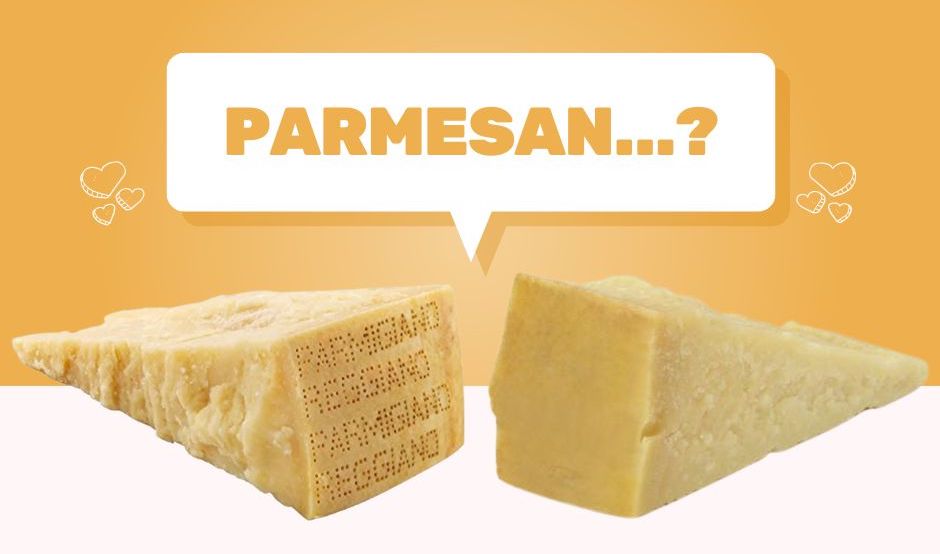Last Updated on January 17, 2024 by Aaron
Parmigiano Reggiano and Parmesan cheese are commonly used interchangeably, but there are large differences between the two. Parmigiano Reggiano is an Italian-made cheese produced with cow’s milk that has been commonly aged for at least 12 months, up to 36 months.
Some others can be found with even longer maturations — from 40 months to over 100 months.
The price of Parmigiano Reggiano is determined by its age, with the longer maturations being much more expensive. For example, one pound of 10 years aged Parmigiano Reggiano can go for about $50 per pound, and it’s not available all the time. We discussed more about parmesan cheese prices in this article.
Table of Contents
Protected Designation of Origin (PDO)
More importantly, this cheese is protected by EU law and can only be produced in certain regions of Italy — Bologna, Reggio Emilia, Mantua, Modena, or Parma — making it an authentic Italian product. It has a lot of criteria to follow as well, including the cattle breeds, feed and bacteria strain, read how it’s produced in this article. They will have stamping and must adhere to strict regulations that help ensure quality and consistency. You’ll also see the fire-branded mark for grade selection and year of production on its rind.
The word “Parmigiano-Reggiano” is trademarked by The Consorzio del Formaggio Parmigiano-Reggiano (the Consorzio). It means that every wheel of Parmigiano-Reggiano will have to be inspected by trained inspectors sent by the consortium before being sold and stamped with “Parmigiano-Reggiano”. We’ve discussed the best parmesan here previously.
On the other hand, “Parmesan” is the English translation of the word “Parmigiano Reggiano” which had been used in Italy and France since the 17th century. Nowadays, parmesan cheese is a generic term used to describe a similar style of hard cheese produced outside of EU countries where the PDO does not apply, such as the United States.
In the US, according to the CFR (Code of Federal Regulations) source, anything called “parmesan” must be cow’s milk cheese with a “granular texture” and “hard and brittle rind”, not less than 32% milkfat, and must be aged 10 months minimum. Apparently, it does not have the same production criteria & regulations that Parmigiano Reggiano must follow and therefore will not have the consistent flavor profile as Parmigiano Reggiano.
In Italy, there is Denominazione di Origine controllata (DOC) law. In France, there is Appellation d’Origine Contrôlée (AOC) and the Appellation d’Origine Protégée (AOP), which is equivalent to the PDO mark protected across Europe. You might also see PGI (protected geographical indication) certified by EU.
It basically says “this product is legit”.
The Imitation
Parmesan cheese doesn’t come from Italy are considered an imitation of Parmigiano Reggiano. Most “parmesan” labeled cheese whether it’s in blocks, grated, or powdered forms are usually not genuine parmesan but it can still be a tasty cheese. In fact, some artisanal parmesan are quite decent, so you be the judge.
These parmesan cheeses are usually cheaper and more accessible, but they won’t have the same flavor profile and texture. The flavor is usually much milder than that of Parmigiano Reggiano.
The rind of Parmigiano Reggiano is the most notable part as it’s filled with flavorful, mushy texture and a nutty aroma. It’ll also have pin-dot marks stenciled on the rind that reads ‘Parmigiano-Reggiano — If the parmesan doesn’t have that, it’s not the real thing.
It’s worth noting that there are “de-rinded” Parmigiano Reggiano. Not an imitation, but “downgraded” defects that are not in line with the PDO standard and with the recognizable rind removed, so they cannot be sold as Parmigiano Reggiano.
Taste Differences
Parmigiano Reggiano has been called the “King of Cheese”. Its quality is considered superior to that of regular parmesan because it has a more complex, deeply nutty flavor profile that melts in your mouth and with a lengthy maturation process. The regular (12-18 months), Vecchio (18-24 months) or Stravecchio (24 to 36 months) is particularly intense and fruity, with an unmistakable flavor. One step further we have stravecchiones (36 months above).
On the other hand, parmesan cheese made in other countries will not have the same complexity of flavor as Parmigiano Reggiano because it does not go through a lengthy maturation process and might contains additives like cellulose powder (to prevent clumping) or potassium sorbate (prevent mold growth), especially in the shredded or grated parmesan. The texture is also different — Parmigiano Reggiano tends to be flaky, granular and crumbly, while parmesan cheese is firm and smooth. Parmesan is usually more acidic and saltier.
Another thing is that regular parmesan made in the US uses pasteurized milk by default whereby a lot of natural flavors are destroyed under high heat which makes them taste milder and less complex. Parmigiano Reggiano, on the other hand, is made with unpasteurized raw milk that gives it more flavor and depth.
Can I substitute Parmesan for Parmigiano-Reggiano?
Yes, but be prepared for a different flavor profile. Parmigiano Reggiano will bring more intense, complex and nutty flavors to the dish with its granular texture that melts in your mouth. While parmesan might provide the same OK taste but it won’t have the depth of flavor or same experience when you bite on it.
If possible, go with the real deal — Parmigiano Reggiano if you want the best flavor. However if budget is an issue or it’s not available in your area, parmesan can be a good substitute as long as you don’t mind sacrificing some of the intensity of flavors and texture.


